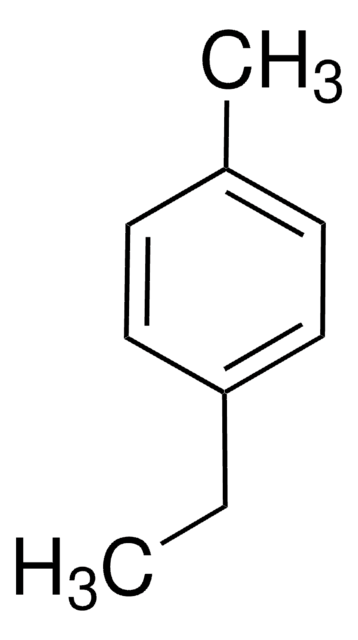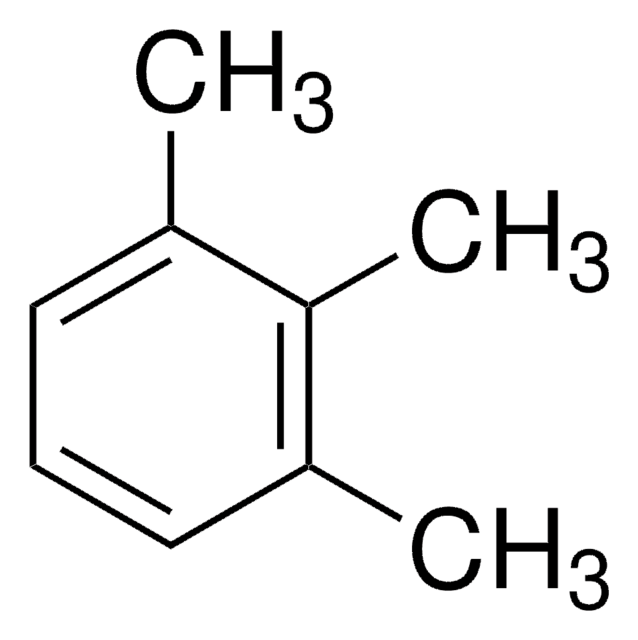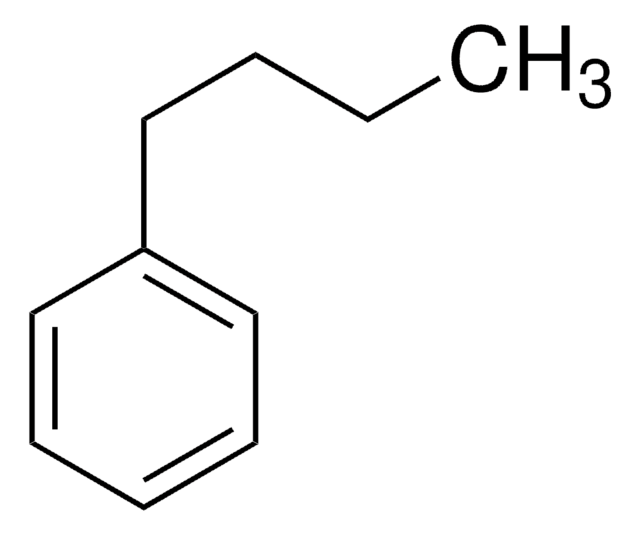E49606
3-Ethyltoluene
99%
Synonym(s):
1-Ethyl-3-methylbenzene
Sign Into View Organizational & Contract Pricing
All Photos(1)
About This Item
Linear Formula:
C2H5C6H4CH3
CAS Number:
Molecular Weight:
120.19
Beilstein:
1850821
EC Number:
MDL number:
UNSPSC Code:
12352100
PubChem Substance ID:
NACRES:
NA.22
Recommended Products
Quality Level
Assay
99%
form
liquid
autoignition temp.
896 °F
refractive index
n20/D 1.496 (lit.)
bp
158-159 °C (lit.)
density
0.865 g/mL at 25 °C (lit.)
SMILES string
CCc1cccc(C)c1
InChI
1S/C9H12/c1-3-9-6-4-5-8(2)7-9/h4-7H,3H2,1-2H3
InChI key
ZLCSFXXPPANWQY-UHFFFAOYSA-N
Looking for similar products? Visit Product Comparison Guide
Application
3-Ethyltoluene is generally used as a model alkylbenzene derivative for bond activation and C(sp3)-H functionalization studies.
Signal Word
Warning
Hazard Statements
Precautionary Statements
Hazard Classifications
Flam. Liq. 3
Storage Class Code
3 - Flammable liquids
WGK
WGK 3
Flash Point(F)
100.4 °F - closed cup
Flash Point(C)
38 °C - closed cup
Personal Protective Equipment
dust mask type N95 (US), Eyeshields, Gloves
Choose from one of the most recent versions:
Already Own This Product?
Find documentation for the products that you have recently purchased in the Document Library.
Customers Also Viewed
A Metal?Free Oxidative Dehydrogenative Diels?Alder Reaction for Selective Functionalization of Alkylbenzenes.
Manna S and Antonchick A P
Chemistry?A European Journal, 23(32), 7825-7829 (2017)
Cu-Facilitated C? O Bond Formation Using N-Hydroxyphthalimide: Efficient and Selective Functionalization of Benzyl and Allylic C? H Bonds.
Lee J M, et al.
Journal of the American Chemical Society, 130(25), 7824-7825 (2008)
Mechanism of C? H Bond Activation of Alkyl-Substituted Benzenes by Cationic Platinum (II) Complexes.
Driver T G, et al.
Organometallics, 24(15), 3644-3654 (2005)
Laura Vallecillos et al.
The Science of the total environment, 666, 235-244 (2019-02-25)
This study describes the implementation of a passive sampling-based method followed by thermal desorption gas-chromatography-mass spectrometry (TD-GC-MS) for the monitoring of volatile organic compounds (VOCs) in industrial atmospheres. However, in order to employ passive sampling as a reliable sampling technique
G M Whited et al.
Journal of bacteriology, 166(3), 1028-1039 (1986-06-01)
Pseudomonas putida BG1 was isolated from soil by enrichment with p-toluate and selection for growth with p-xylene. Other hydrocarbons that served as growth substrates were toluene, m-xylene, 3-ethyltoluene, and 1,2,4-trimethylbenzene. The enzymes responsible for growth on these substrates are encoded
Our team of scientists has experience in all areas of research including Life Science, Material Science, Chemical Synthesis, Chromatography, Analytical and many others.
Contact Technical Service










